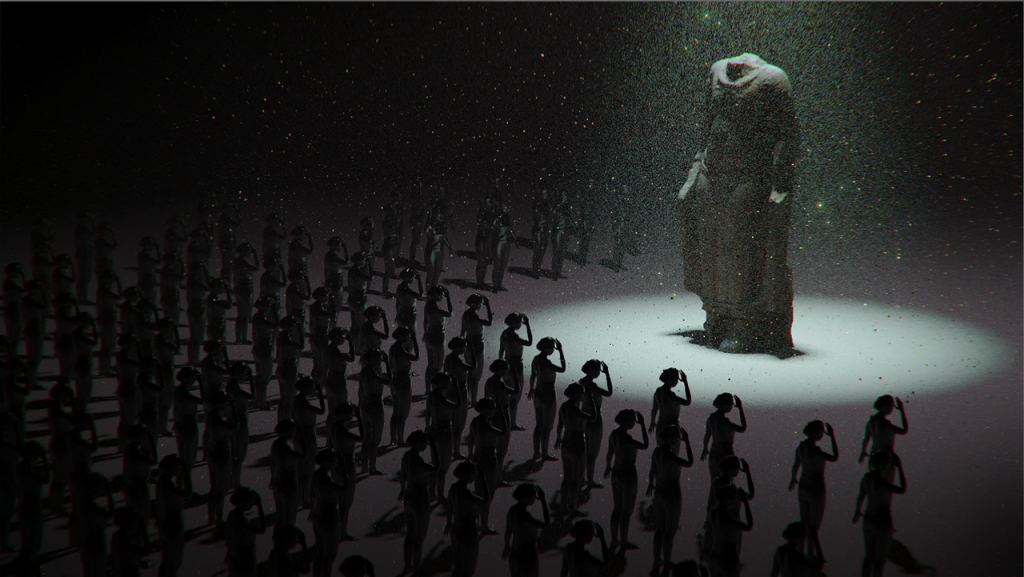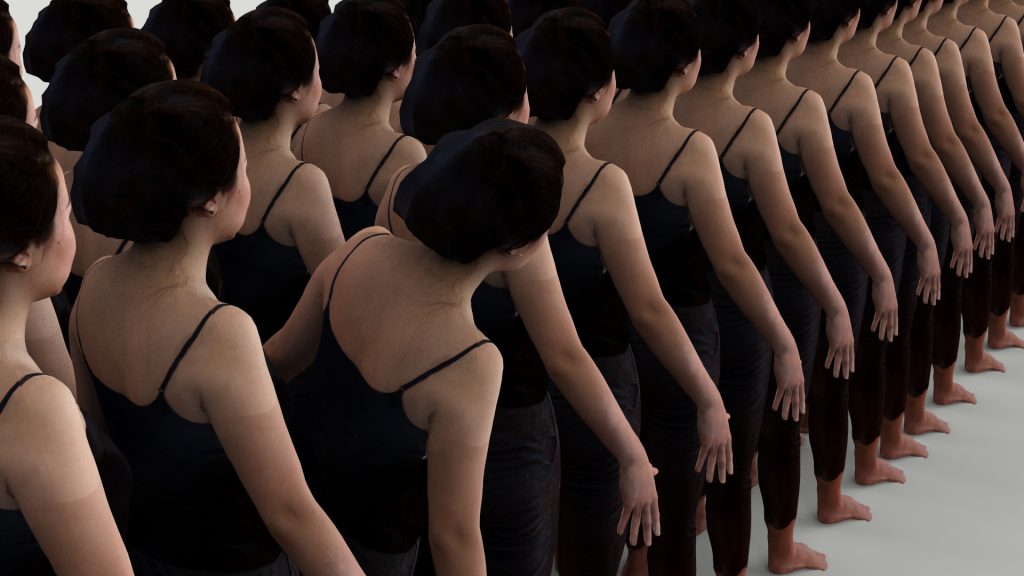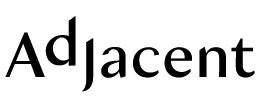Issue 6: Old / New / Next
Unadulterated Wonder: Imagining the Future of Imagination
During a recent visit to the Park Avenue Armory, I encountered a quote by German artist and filmmaker Hito Steyerl. “What does a thing have to say about things?” The quote was in the context of her study on the subject vs. the object, where she examined the implications of wanting to become an object: “[…] as the struggle to become a subject became mired in its own contradictions, a different possibility emerged. How about siding with the object for a change? Why not affirm it? Why not be a thing? An object without a subject? A thing among other things?”
To further explore the possibility brought on by this shift of mindset, she references David Bowie’s 1977 single “Heroes” as a milestone that turned visual identification into participation: “Bowie [sings] to himself from three simultaneous angles, with layering techniques tripling his image; not only has Bowie’s hero been cloned, he has above all become an image that can be reproduced, multiplied, and copied, a riff that travels effortlessly through commercials for almost anything, a fetish that packages Bowie’s glamorous and unfazed postgender look as product. Bowie’s hero is no longer a larger-than-life human being carrying out exemplary and sensational exploits, and he is not even an icon, but a shiny product endowed with posthuman beauty: an image and nothing but an image.” As a Bowie fan, I reacted with a visceral recognition of the fluidity to shift from the subject to the object, the freedom to remove their dependency on each other, or perhaps even the interchangeability between the two—all driven by a clear intention. I read on as a voice emerged in my head, “What does imagination have to say about imagination?”
I realized that I had drifted from Steyerl’s original intent. This oddly fascinating voice was a complete tangent, not even a derivative; but perhaps it’s worth a closer look. When I talk about imagination, people either assume they know what I mean or ask me to define it within a specific context. I have always linked imagination to courage—the ability to seek and pursue the seemingly impossible without fear of being compared or judged with what’s currently acceptable. Obviously, there are other ways to define imagination and there’s no denying that a clear definition agreed upon by the collective consciousness could inspire more fruitful discussions on the subject. Yet, I have this nagging suspicion that we are missing something potentially profound.

What if imagination simply can’t be defined? What if imagination is something we feel and know on a somatic level, instead of it being understood at an intellectual and linguistic level? What if imagination is the act of embodying the collective consciousness, or even the collective unconscious? By asking what imagination has to say about itself, and seeing it both as the subject and the object, what new dimensions might we discover?
Our capacity to imagine is closely tied to our pure essence, the human-ness we are born with and can learn to cultivate. We know that children have unbridled imagination. But then, we dismiss anything such imagination produces with antithetical double-speak, as wonderful but impractical, incredible but implausible. Considering the quality of children’s imaginations, we might conclude that these wild ideas exist because children don’t yet know what’s (im)possible. A more important but less recognized factor is their openness and ability to listen to all voices. Before they learn to discern whose voice is “important” and “correct,” they absorb everything they encounter with equal measures of enthusiasm and acceptance.
I am not advocating for children to take over the world. I am, however, deeply curious about what would happen if we allowed unadulterated wonder and unbiased inclusion to boost, or even change the purpose or nature of our imagination. If imagination is something that cannot be defined, can it therefore be nurtured, empowered and personified to reimagine itself? What would imagination want for itself if it had its own consciousness? This is not a rhetorical question; rather, it’s a matter of surrendering logic and control in hopes of capturing the essence of imagination.
The issue isn’t about defining what imagination is but seeing what has already occurred and what we can do with it. The world we live in today is a tomorrow that arrived yesterday, but only for the privileged few who are free to have access to the knowledge needed to support trailblazing experimentations. From Silicon Valley technorati to Hollywood moguls, vanguard scientists to pioneering artists, anyone with this access to future imagination has already begun to create new realities that once seemed only possible in science fiction. Imagination is inherent to being human and as such, belongs to every human being. It doesn’t rely on privilege, but the confidence, agency, and power to act on imagination often does. Without taking action, the imagination lessens its hold on the new. How do we democratize imagination—with its fluidity to shift between being the subject and the object—to enable the full participation of humanity in shaping its own futures?
This, to me, is the most pressing issue when it comes to imagining any kind of future. Thus, when asked to write a future imagination manifesto, I want imagination to declare its own independence, free from the deception of bias; free from anxiety about the future; free from the tyranny of power; free from the abuse of privilege; free from the temptation of greed; free from the compulsion to label or brand; free from the fear of scarcity; free from the quixotic allure of progress; free from the finitude in reality. This declaration of independence means to democratize imagination without feeling compelled to define it. A ‘lit crit’ equivalency could read as: the instructions for the poem are the poem.
I frequently get asked about how new technologies like AI or CRISPR will affect creativity and the imagination. At the risk of sounding evasive, my answer would have to be based on asking other questions: As we augment human capacity, are we also making an earnest attempt to understand, actualize and expand human potential? Just because we can, does that mean we should? Why do we even propose that technology directly affects imagination when we should be using our imagination to affect technology? Most importantly, who is the “we” in these questions? Through my collaboration with Kamal Sinclair, who developed an incredible body of work on how we might wield the power of emerging technologies to better humanity, I became intrigued by a series of video interviews she conducted. The subjects of these interviews are not futurists or experts in science or technology; they are artists, makers, and everyday people who, upon being asked the same question about future technologies, consistently enrich the discussion by expanding the range of imagining the future. The inclusion of their voices demonstrates the critical importance of diversity when considering differing points of view.
Octavia Butler’s Parable Series (Parable of the Sower and its sequel Parable of the Talents) tells a sci-fi story set against a chaotic America between the 2020s and 2030s that eerily mirrors the post-reality MAGA narrative we find ourselves in today. As a pillar of Afrofuturism, the significance of Butler’s imagination goes beyond its prophetic power. By writing black female protagonists into science fiction, her most meaningful cultural contribution may be proposing a paradigm shift about gender and race. She centers black and female brilliance, historically oppressed or ignored, in the domain of designing the future. The resulting liberation from that sustained oppression becomes the necessary act to democratize imagination and decolonize a collective future. The plot of her stories matters less than the seemingly intangible transference of power that gives agency to people whose innate capacity to imagine a future has been disenfranchised, severely limiting their participation in shaping that future.
Mainstream entertainment lately has profited in a surge in beautifully crafted stories about dystopian futures. But if we look at the re-imagining of an American classic of literature, such as Hulu’s The Handmaid’s Tale based on Margaret Atwood’s 1985 novel, or dark speculations triggered by a sinister view on invasive technology, such as Netflix’s Black Mirror, there seems to be a shortage of diverse perspectives to inspire a balanced ecosystem of future imagination. The future is neither dystopian nor utopian if our imagination reconsiders the past, present, and future with the full participation of multiple voices.
As I attempt to untangle the relationship between power structures and technological readiness in the context of how we might imagine different futures, a scene came to me from HBO’s popular series Years and Years, when Celeste carries on a horrifying conversation with a nurse after her daughter’s friend suffers a failed surgery to replace her own human eye with a digital camera. The nurse observes: “…[People on the ship perform cheap surgery]; There was facelift in the 90s, gender reassignment in the 2000s, and now they’ve discovered transhumans.” (Ep3: 52:48) The show imagines a future very much like the present, by reiterating it’s most glaring societal ill: an advancement in technology that does not include, much less improve the material conditions of a vulnerable population. Instead, access to safe and affordable surgery remains limited, and new technology creates opportunities for the powerful and unscrupulous to exploit new populations.
Imagination remains a professional sport for those with power and an unfulfilled dream for those without it. As writer Eric Liu eloquently states, “[The] powerful tell tales about why they deserve their status, so that they can feel better about it. So do the powerless. Together, these two sets of stories form an unseen edifice, a prison of the imagination that shrinks everyone’s scope of possibility about alternative arrangements and allocations of power.” A prison of the imagination created by polarizing stories will experience liberation only when we re-examine the role of the subject vs.the object, and recognizing that imagination contracts when power is concentrated and it expands when that power gets distributed. Empowerment is what fuels imagination to thrive and therefore, lead an unencumbered life of its own.

As far as AI and CRISPR are concerned, no matter how brilliant and imaginative they may be, what we don’t need is some small group of intellectual elites pondering in isolation. What we do need is more voices to engage in the collective process of inquiry. We need to liberate our imagination by feeding it the nutrient of inclusion. Stephanie Dinkins’ work with Bina48 is a perfect example of this point: How might an ongoing dialogue between a black female artist and the world’s most advanced social robot inform our understanding of human-to-robot relations and inevitably reveal gaps in our imagination within the current contexts and frameworks of human-to-human relations? The active participation of “unlikely players” would most likely catalyze a democratized imagination of the future.
Another example of inclusion is documentarian Kat Cizek’s research on co-creation. Situated in MIT’s Co-Creation Studio, Cizek’s work with an impressive group of collaborators identifies different types of co-creation in media: within communities (in person and on-line); across disciplines and organizations; and, increasingly, among humans co-creating with living systems and artificial intelligence. In co-creation, projects emerge from a process and evolve from within communities and with people rather than for or about them. Aiming to avoid the pitfalls of a single-author vision, this critical study also explores the risks and the practical lessons from the field on how to co-create with an ethos grounded in principles of equity and justice. These journeys of co-creation not only shed light on future imagination but, with more relevance and insight, uncover blind spots as we let our imagination go to the past, having the lessons of history change history itself and make room for a more beautiful and inclusive future.
The ambition of the Future Imagination Fund at Tisch is to instigate a methodical pursuit to enable a collective imagination that is socially democratic, culturally diverse and economically equitable. Multiple visions of that aforementioned more beautiful future can then transcend our current understanding of imagination itself. My hope is that instigating this shift in how we perceive imagination is imbued with a sense of confidence and optimism in our potential to embody not only perceivable and observable values, but also those values that may be unknowable, to be revealed by recognizing our profound connection to one another.
These connections exist without language and definition, so the next time we feel compelled to describe or define imagination, think about this beautiful passage taken from an interview with Laurie Anderson: Your interpretation of what black is [has] always [been] influenced by, “Is it surrounded by lime green or baby pink?” As the sun rises and the sky goes through every single phase that it could, from black to blue, including pink and red, you realize that even so called, “Seeing things,” is an act of comparison, memory, labeling, and fiction. […] I’ve thought, “Oh, the sky is green!” I said, “Because it’s ringed with pink.” “Oh my, it’s brown!” “Because it’s against dark blue.”
Our future imagination, like these colors, cannot be seen in isolation. When we permit and make space to imagine as one collective and connected organism, a more beautiful future will come into existence, as majestically and naturally as the sun will rise the next morning.
